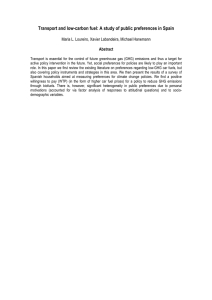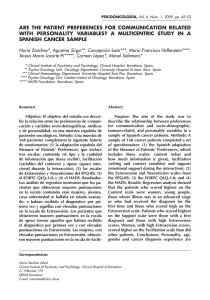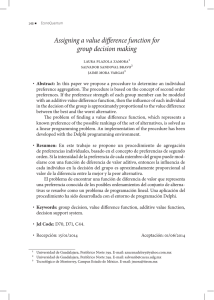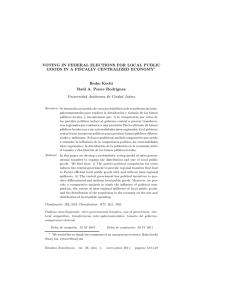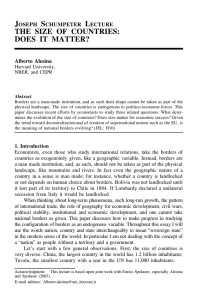Investigación Operativa The uniform rule in the division
Anuncio
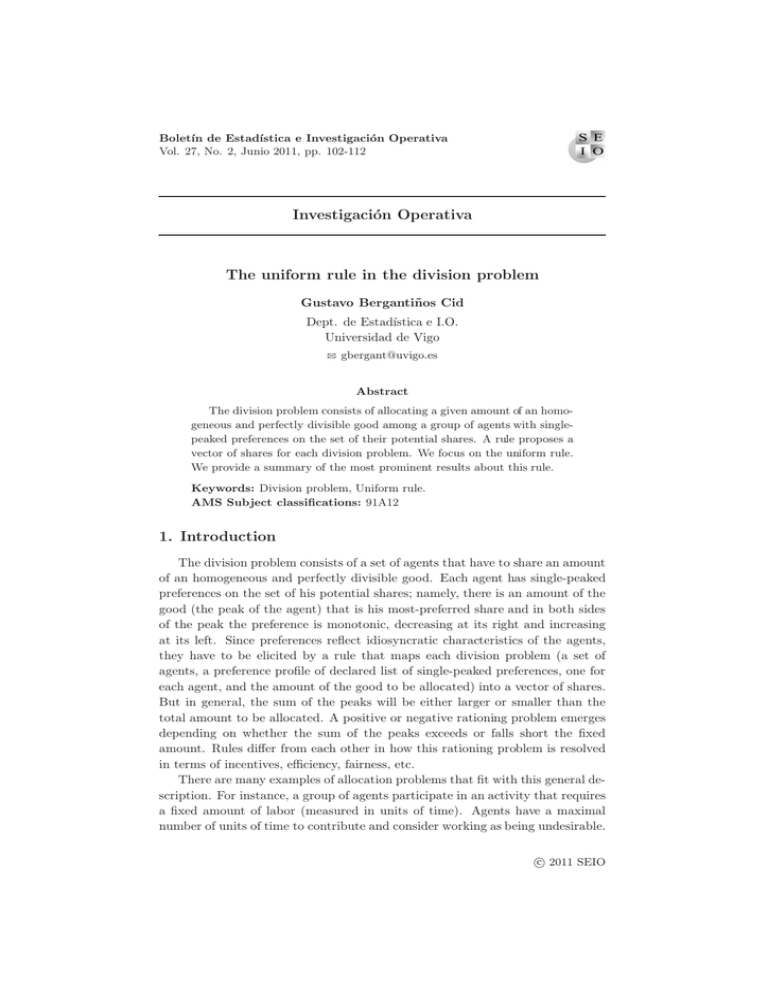
Boletı́n de Estadı́stica e Investigación Operativa
Vol. 27, No. 2, Junio 2011, pp. 102-112
Investigación Operativa
The uniform rule in the division problem
Gustavo Bergantiños Cid
Dept. de Estadı́stica e I.O.
Universidad de Vigo
B gbergant@uvigo.es
Abstract
The division problem consists of allocating a given amount of an homogeneous and perfectly divisible good among a group of agents with singlepeaked preferences on the set of their potential shares. A rule proposes a
vector of shares for each division problem. We focus on the uniform rule.
We provide a summary of the most prominent results about this rule.
Keywords: Division problem, Uniform rule.
AMS Subject classifications: 91A12
1. Introduction
The division problem consists of a set of agents that have to share an amount
of an homogeneous and perfectly divisible good. Each agent has single-peaked
preferences on the set of his potential shares; namely, there is an amount of the
good (the peak of the agent) that is his most-preferred share and in both sides
of the peak the preference is monotonic, decreasing at its right and increasing
at its left. Since preferences reflect idiosyncratic characteristics of the agents,
they have to be elicited by a rule that maps each division problem (a set of
agents, a preference profile of declared list of single-peaked preferences, one for
each agent, and the amount of the good to be allocated) into a vector of shares.
But in general, the sum of the peaks will be either larger or smaller than the
total amount to be allocated. A positive or negative rationing problem emerges
depending on whether the sum of the peaks exceeds or falls short the fixed
amount. Rules differ from each other in how this rationing problem is resolved
in terms of incentives, efficiency, fairness, etc.
There are many examples of allocation problems that fit with this general description. For instance, a group of agents participate in an activity that requires
a fixed amount of labor (measured in units of time). Agents have a maximal
number of units of time to contribute and consider working as being undesirable.
c 2011 SEIO
!
103
G. Bergantiños
Suppose that labor is homogeneous and the wage is fixed. Then, strictly monotonic and quasi-concave preferences on the set of bundles of money and leisure
generate single-peaked preferences on the set of potential shares where the peak
is the amount of working time associated to the optimal bundle. Similarly, a
group of agents join a partnership to invest in a project (an indivisible bond
with a face value, for example) that requires a fixed amount of money (neither
more nor less). Their risk attitudes and wealth induce single-peaked preferences
on the amount to be invested. In both cases, it is required that a rule solves the
rationing problem arising from a vector of peaks that do not add up the needed
amount.
One of the most important topics of these problems is the axiomatic characterizations of rules. The idea is to propose desirable properties and find out
which of them characterize every rule. Properties often help agents to compare
different rules and to decide which rule is preferred for a particular situation.
The uniform rule tries to divide the good as equally as possible keeping the
bounds imposed by efficiency. It has played a central role in the division problem
because it is the unique rule satisfying different sets of desirable properties.
For instance, Sprumont (1991) shows that the uniform rule is the unique rule
satisfying strategy-proofness, efficiency and equal treatment of equals. In this
paper we review the main axiomatic characterizations of the uniform rule. We
also provide a list of papers studying other aspects of the uniform rule. Besides,
some extensions of this rule to more general problems are mentioned.
The paper is organized as follows. In Section 2 we introduce the division
problem. In Section 3 we give a list of properties that a rule should satisfy. In
Section 4 we study the uniform rule.
2. The division problem
In this section we introduce the mathematical model in which we focus on.
Let t > 0 be an amount of an homogeneous and perfectly divisible good that
has to be allocated among a finite set N of agents according to their preferences.
Since we will be considering situations where the amount of the good t and the
finite set of agents may vary, let N be the set of positive integers and let N be
the family of all non-empty and finite subsets of N. The set of agents is then
N ∈ N with cardinality n = |N |.
Agent i’s preferences #i are a complete preorder (a complete, reflexive, and
transitive binary relation) on the interval [0, t]. Given a preference #i let $i
be the antisymmetric binary relation induced by #i (i.e., for all xi , yi ∈ [0, t],
xi $i yi if and only if yi #i xi does not hold) and let ∼i be the indifference
relation induced by #i (i.e., for all xi , yi ∈ [0, t], xi ∼i yi if and only if xi #i yi
and yi #i xi ). We assume that #i is single-peaked on [0, t] and we will denote
by pi ∈ [0, t] agent i’s peak. Formally, a preference #i is single-peaked on [0, t] if
The uniform rule in the division problem
104
(P.1) there exists pi ∈ [0, t] such that pi $i xi for all xi ∈ [0, t]\{pi };
(P.2) xi $i yi for any pair of shares xi , yi ∈ [0, t] such that either yi < xi ≤ pi
or pi ≤ xi < yi .
A profile #N = (#i )i∈N is an n−tuple of preferences satisfying properties
(P.1) and (P.2). Given a profile #N and agent i’s preferences ##i we denote by
(##i , #N \{i} ) the profile where #i has been replaced by ##i and all other agents
have the same preferences. Similarly, given a subset of agents S ⊆ N , we will
write often #N as (#S , #N \S ). When no confusion arises we denote the profile
#N by #.
A division problem is a triple (N, #, t) where N ∈ N is the set of agents,
#= (#i )i∈N is a profile and t ≥ 0 is the amount of the good to be divided. Let
P be the set of all division problems.
Let us clarify this definition with an example.
Example 1. Two professors have decided to give a course of 60 hours in a
master. The salary per hour is 100e. Professor 1 would like to teach 40 hours.
To teach less than 40 hours is worse because he gets less money. To teach more
than 40 hours is also worse because he will need to prepare topics that he does
not know at all. Professor 2 would like to teach 50 hours. Similarly, to teach
less than 50 hours, or more than 50, is worse. We can model this situation as a
division problem where the set of agents is N = {1, 2} (the professors), t = 60
(the number of hours of the course), and the preferences are as follows. Given
x, y ∈ [0, 60] , x #1 y if and only if |x − 40| ≤ |y − 40| , namely the distance from
x to 40 is not larger than the distance from y to 40. Analogously, x #2 y if and
only if |x − 50| ≤ |y − 50| .
The question addressed by the literature is, how to divide the good among
the agents? It has two stages. First to know the set of possible shares. Second,
to select one of them.
The set of feasible allocations of problem (N, #, t) ∈ P is
,
)
F A (N, #, t) = (x1 , ..., xn ) ∈ RN
|
x
=
t
and
for
each
i
∈
N,
x
∈
[0,
t]
.
i
i
+
i∈N
A rule is a systematic way of solving the division problem by selecting in each
problem one of its feasible allocations. Namely, a rule f is a mapping on the set of
problems with the property that for all (N, #, t) ∈ P, f (N, #, t) ∈ F A (N, #, t).
105
G. Bergantiños
3. Some properties
In this section we introduce a list of properties that a rule should satisfy. We
first give the intuitive idea and later the formal definition.
Rules require each agent to report a preference. A rule is strategy-proof if
it is always in the best interest of agents to reveal their preferences truthfully;
namely, it induces truth-telling as a weakly dominant strategy in the direct
revelation game generated by the rule.
Property 1. A rule f satisfies strategy-proofness if for each problem (N, #N , t) ∈
P, agent i ∈ N , and preference ##i ,
. .
/ /
fi (N, #N , t) #i fi N, ##i , #N \{i} , t .
Given a problem (N, #N , t) ∈ P we say that agent i ∈ N manipulates f at
/ /
. .
profile #N via ##i if fi N, ##i , #N \{i} , t $i fi (N, #N , t). Thus, a rule f is
strategy-proof if no agent can manipulate it at any profile.
A rule is efficient if it always selects a Pareto optimal allocation.
Property 2. A rule f satisfies efficiency if for each problem (N, #, t) ∈ P
there is no feasible allocation (yj )j∈N ∈ F A(N, #, t) with the property that
yi #i fi (N, #, t) for all i ∈ N and yj $j fj (N, #, t) for some j ∈ N.
Is it immediate to see that the following remarks holds.
Remark 1 Let f be an efficient rule and let (N, #, t) ∈ P be a problem.
)
(R.1) If
pi ≥ t then fi (N, #, t) ≤ pi for all i ∈ N .
i∈N
)
(R.2) If
pi < t then fi (N, #, t) ≥ pi for all i ∈ N.
i∈N
A rule satisfies equal treatment of equals if two agents with identical preferences receive the same share.
Property 3. A rule f satisfies equal treatment of equals if for each problem
(N, #, t) ∈ P, #i =#j implies fi (N, #, t) = fj (N, #, t) .
A rule f is envy free if no agent can strictly prefer the share received by
another agent.
Property 4. A rule f satisfies envy-freeness if for each problem (N, #, t) ∈ P
and each pair of agents i, j ∈ N , fi (N, #, t) #i fj (N, #, t) holds.
A rule f is individually rational from equal division if all agents receive a
share that is at least as good as the equal division share.
106
The uniform rule in the division problem
Property 5. A rule f satisfies individual rationality from equal division if for
each problem (N, #, t) ∈ P and each i ∈ N ,
fi (N, #, t) #i
t
.
n
The next property we want to consider is related to the behavior of the rule
when the amount t to be shared changes. However, it only imposes conditions
on the rule whenever the change of the amount to be shared does not change the
sign of the rationing problem: if the good is scarce, an increase of the amount
to be shared should make all agents better off and if the good is too abundant,
a decrease of the amount to be shared should make all agents better off.
Property 6. A rule f satisfies one-sided resource monotonicity if for all two
)
problems (N, #, t) , (N, #, t# ) ∈ P with the property that either t ≤ t# ≤
pi
i∈N
)
or
pi ≤ t# ≤ t then fi (N, #, t# ) #i fi (N, #, t) for all i ∈ N.
i∈N
A rule is consistent if the following requirement holds. Apply the rule to a
given problem and assume that a subset of agents leave with their corresponding
shares. Consider the new problem formed by the set of agents that remain with
the same preferences that they had in the original problem and the total amount
of the good minus the sum of the shares received by the subset of agents that
already left. Then, the rule does not require to reallocate the shares of the
remaining agents.
Property 7. A rule f satisfies consistency if for each problem (N, #N , t) ∈ P,
each S ⊂ N and each i ∈ S,
fi (N, #N , t) = fi (S, #S , t −
)
fj (N, #N , t)).
j∈N \S
One-sided population monotonicity requires that all agents initially and finally present gain upon an increase in the population if initially there is too
much of the good and after the population increase there is still too much of the
commodity; and to gain upon a decrease in the population if initially there is
not enough of the commodity and after the population decrease there is still not
enough of the commodity.
Property 8. A rule f satisfies one-sided population monotonicity if for each
problem (N, #N , t) ∈ P, each S ⊂ N , and each i ∈ S, fi (N, #N , t) #i fi (S, #S , t)
)
)
)
pj ≤ t and fi (S, #S , t) #i fi (N, #N , t) when t ≤
pj ≤
when
pj ≤
j∈N
j∈S
) j∈S
pj .
j∈N
107
G. Bergantiños
Replication invariance says that if an allocation is recommended for some
division problem, then for any order of replication of the problem, the replicated
allocation is also recommended for the replicated division problem.
Given the division problem (N, #, t) we define the k-replica as k ⊗ (N, #, t) =
(N # , ## , t# ) where N # = N1 ∪ ....Nk ; Nl = {l1 , ..., ln } for all l = 1, ..., k; ##li =#i
for all l = 1, ..., k and all i = 1, ..., n; and t# = kt. Namely, the k-replica is defined
as the problem obtained by replicating k times the original division problem.
Property 9. A rule f satisfies replication invariance if for each problem (N, #
, t) ∈ P and each natural number k,
fli (k ⊗ (N, #, t)) = fi (N, #, t)
for all l = 1, ..., k and all i = 1, ..., n.
Continuity says that small changes in the amount to be divided t produces
small changes in the allocation received by the agents.
Property 10. A rule f satisfies continuity if for each problem (N, #, t) ∈ P
0
1∞
and each sequence of problems (N, #k , tk ) k=1 ⊂ P satisfying that lim tk = t
k→∞
2
3
45
k
k!
k k!
#
and #i = #i =#i in 0, min t , t , t for all i ∈ N and all k, k then,
lim f (N, #k , tk ) = f (N, #, t).
k→∞
Separability requires that for two problems with the same population, but
possibly different social endowments, in which the preferences of agents may
change, if there is a subgroup of agents whose preferences are the same and the
total amounts awarded to them are the same, then the amount awarded to each
agent in the subgroup should be the same.
Property 11. A rule f satisfies separability if for each pair of problems
(N, #, t) ∈ P and (N, ## , t) ∈ P and each S ⊂ N satisfying that #S =##S and
)
)
fj (N, #, t) =
fj (N, ## , t) then, fi (N, #, t) = fi (N, ## , t) for all i ∈ S.
j∈S
j∈S
Suppose that the change in population or preferences should not turn the
division problem from one in which there is “too little” of the commodity to
one in which there is “too much,” or conversely. One-sided welfare domination
under preference replacement requires that, a change in the preferences of some
members of the society should affect the agents whose preferences have not
changed in the same direction.
Property 12. A rule f satisfies one-sided welfare domination under preference
replacement if for each pair of problems (N, #, t) ∈ P and6(N, ## , t) ∈ P7and
)
) #
each S ⊂ N satisfying that #S =##S and either t ≥ max
pj ,
pj or
j∈N
j∈N
108
The uniform rule in the division problem
t ≤ min
6
)
j∈N
pj ,
)
j∈N
p#j
7
then, either fj (N, #, t) #j fj (N, ## , t) for all j ∈ S or
fj (N, ## , t) #j fj (N, #, t) for all j ∈ S.
4. The uniform rule
In this section we introduce the uniform rule and we provide some results
about such rule. We focus in the axiomatic characterizations of the uniform rule.
We also provide a list of papers studying other aspects of the rule. Finally, we
mention some papers studying extensions of the uniform rule to more general
problems.
The uniform rule U is defined as follows: for each division problem (N, #, t)
and for each i ∈ N ,
)
pj < t
max {β, pi } if
j∈N
)
Ui (N, #, t) =
pj ≥ t,
min {β, pi } if
j∈N
where β solves the equation
)
Ui (N, #, t) = t.
j∈N
Namely, U tries to allocate the good as equally as possible, keeping the
)
efficient constraints binding (see Remark 1): if
pi ≥ t then Ui (N, #, t) ≤ pi
i∈N
)
for all i ∈ N , and if
pi < t then Ui (N, #, t) ≥ pi for all i ∈ N .
i∈N
Notice that U does not depends on the whole preference of the agents, only
on their peaks {pi }i∈N .
Example 2. Let (N, #, t) be such that N = {1, 2} and t = 10. We compute U
in several cases:
• p1 = 3, p2 = 4. In this case p1 + p2 < t, β = 5 and U (N, #, t) = (5, 5) .
• p1 = 3, p2 = 6. In this case p1 + p2 < t, β = 4 and U (N, #, t) = (4, 6) .
• p1 = 3, p2 = 8. In this case p1 + p2 ≥ t, β = 7 and U (N, #, t) = (3, 7) .
• p1 = 6, p2 = 8. In this case p1 + p2 ≥ t, β = 5 and U (N, #, t) = (5, 5) .
We now give some axiomatic characterizations of the uniform rule. We classify it in two groups. In the first theorem we consider the axiomatic characterizations where the set of agents is fixed. In the second theorem we consider the
results where the population is variable.
109
G. Bergantiños
Theorem 4.1. The uniform rule is the unique rule satisfying the following
properties:
1. Strategy-proofness, efficiency, and equal treatment of equals.
2. Strategy-proofness, efficiency, and envy-freeness.
3. Envy-freeness and one-sided resource monotonicity.
4. Efficiency, envy-freeness, continuity, and separability.
5. Separability, individual rationality from equal division, and one-sided resource monotonicity.
Proof of Theorem 4.1. The proof of these results can be found in:
1. Sprumont (1991) and Ching (1994).
2. Sprumont (1991).
3. Thomson (1994b) and Ehlers (2002).
4. Chun (2003), Chun (2006), and Klaus (2006).
5. Chun (2003), Chun (2006), and Klaus (2006). !
Theorem 4.2. The uniform rule is the unique rule satisfying the following
properties:
1. Consistency, efficiency, and envy-freeness.
2. Consistency, efficiency, and individual rationality from equal division.
3. Consistency, individual rationality from equal division, and one-sided resource monotonicity.
4. Consistency, one-sided population monotonicity, and replication invariance.
5. Efficiency, envy-freeness, replication invariance, and one-sided welfare domination under preference replacement.
Proof of Theorem 4.2. The proof of these results can be found in:
1. Thomson (1994a) and Dagan (1996).
The uniform rule in the division problem
110
2. Thomson (1994a) and Dagan (1996).
3. Sonmmez (1994).
4. Sonmmez (1994).
5. Thomson (1997). !
The uniform rule has been studied also in other papers as Barberá et al
(1997), Bochet and Sakai (2010), Chun (2000), Ching (1992), Ehlers (2002),
Kesten (2006), Klaus (2001), Massó and Neme (2001, 2004, 2007), Mizobuchi
and Serizawa (2006), Moreno (2002), Moulin (1999), Schummer and Thomson
(1997), Thomson (2010), and Weymark (1999).
The uniform rule has been also extended to more general problems. For
instance in Bergantiños et al (2011a, 2011b), Kar and Kibris (2008), Kibris
(2003), Kibris and Kucuksenel (2009), Kim (2010), and Manjunath (2010).
References
[1] Barbera S., Jackson M. and Neme A. (1997). Strategy-proof allotment rules.
Games and Economic Behavior 18, 1-21.
[2] Bergantiños G., Massó J. and Neme A. (2011a). The division problem with
voluntary participation. Social Choice and Welfare, forthcoming.
[3] Bergantiños G., Massó J. and Neme A. (2011b). The
vision
problem
with
maximal
capacity
constraints.
http://webs.uvigo.es/gbergant/research.html.
diIn
[4] Bochet O. and Sakai T. (2010). Secure implementation in allotment
economies. Games and Economic Behavior 68, 35-49.
[5] Chun Y. (2000). Distributional properties of the uniform rule in economies
with single-peaked preferences. Economics Letters 67, 23-27.
[6] Chun Y. (2003). One-sided population monotonicity, separability, and the
uniform rule. Economics Letters 78, 343-349.
[7] Chun Y. (2006). The separability principle en economies with single peaked
preferences. Social Choice and Welfare 26, 239-253.
[8] Ching S. (1992). A Simple Characterization of the Uniform Rule. Economics
Letters 40, 57-60.
[9] Ching S. (1994). An Alternative Characterization of the Uniform Rule. Social Choice and Welfare 11, 131-136.
111
G. Bergantiños
[10] Dagan N. (1996). A note on Thomson’s characterization of the uniform rule.
Journal of Economic Theory 69, 255-261.
[11] Ehlers L. (2002). Resource-monotonic allocation when preferences are
single-peak. Economic Theory 20, 113-131.
[12] Kar A. and Kibris O. (2008). Allocating multiple estates among agents with
single-peaked preferences. Social Choice and Welfare 31, 641-666.
[13] Kesten O. (2006). More on the uniform rule: characterizations without
Pareto optimality. Mathematical Social Sciences 51, 192-200.
[14] Kibris O. (2003). Constrained allocation problems with single-peaked preferences: an axiomatic analysis. Social Choice and Welfare 20, 353-362.
[15] Kibris O. and Kucuksenel S. (2009). Uniform trade rules for uncleared markets. Social Choice and Welfare 32, 101-121.
[16] Kim S. (2010). The separability principle for the division problem with participation constraints. In http://www.saet.illinois.edu/papers\_and\
_talks/event-04/Sunyoung\%20Kim.pdf.
[17] Klaus B. (2001). Uniform allocation and reallocation revisited. Review of
Economic Design 6, 85-98.
[18] Klaus B. (2006). A note on the separability principle in economies with
single-peaked preferences. Social Choice and Welfare 26, 255-261.
[19] Manjunath V. (2010). When too little is as good as nothing at all: rationing a disposable good among satiable people with acceptance thresholds. In http://www.rochester.edu/College/gradstudents/vmanjuna/
Vikram\_Manjunath/Vikram\_Manjunath\_files/Rationing.pdf.
[20] Masso J. and Neme A. (2001). Maximal domain of preferences in the division
problem. Games and Economic Behavior 37, 367-387.
[21] Masso J. and Neme A. (2004). A maximal domain of preferences for
strategy-proof, efficient, and simple rules in the division problem. Social
Choice and Welfare 23, 187-206.
[22] Massó J. and Neme A. (2007). Bribe-proof rules in the division problem.
Games and Economic Behavior 61, 331-343.
[23] Mizobuchi H. and Serizawa S. (2006). Maximal domain for strategy-proof
rules in allotment economies. Social Choice and Welfare 27, 195-210.
[24] Moreno B. (2002). Single-peaked preferences, endowments and population
monotonicity. Economics Letters 75, 87-95.
The uniform rule in the division problem
112
[25] Moulin H. (1999). Rationing a commodity along fixed paths. Journal of
Economic Theory 84, 41-72.
[26] Schummer J. and Thomson W. (1997). Two derivations of the uniform rule
and an application to bankruptcy. Economics Letters 55, 333-337.
[27] Sonmez T. (1994). Consistency, monotonicity, and the uniform rule. Economics Letters 46, 229-235.
[28] Sprumont Y. (1991). The division problem with single-peaked preferences:
a characterization of the uniform allocation rule. Econometrica 59, 509-519.
[29] Thomson W. (1994a). Consistent solutions to the problem of fair division
when preferences are single-peaked. Journal of Economic Theory 63, 219245.
[30] Thomson W. (1994b). Resource-monotonic solutions to the problem of fair
division when preferences are single-peak. Social Choice and Welfare 11,
205-223.
[31] Thomson W. (1997). The replacement principle in economies with singlepeaked preferences. Journal of Economic Theory 76, 145-168.
[32] Thomson W. (2010). Implementation of solutions to the problem of fair
division when preferences are single-peaked. Review of Economic Design
14, 1-15.
[33] Weymark J. (1999). Sprumont’s characterization of the uniform rule when
all single-peaked preferences are admissible. Review of Economic Design 4,
389-393.
About the author
Gustavo Bergantiños is full professor at the Department of Statistics and
Operations Research of the University of Vigo. Most of his teaching was in the
Faculty of Economics of the University of Vigo. His main research topics are
Game Theory and Social Choice. This paper is about Social Choice.
